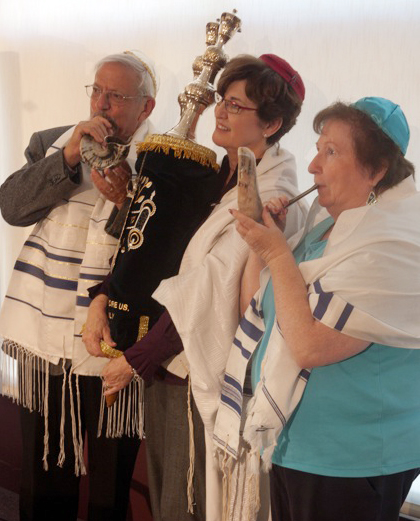
Sept. 4 will mark the beginning of a 10-day period so sacred in Judaism that it is known in English as “Days of Awe” or “High Holy Days.” Joining with Jews around the world, members of South Valley’s Congregation Emeth will participate in ancient prayers, fasting and other traditional rituals that reflect the essence of their faith.
Rosh Hashanah (literally “Head of the Year”) begins at sundown Sept. 4 and begins the year 5774, the years being dated from the rabbinic counting of the moment of creation. This 10-day period will end at sundown Sept. 14, at the conclusion of the most sacred day, Yom Kippur (in English, “Day of Atonement”).
Those who notice such things may wonder why this holiday period seems to change time period from year to year. Well, there is an interesting story behind this.
The traditional Jewish calendar is based on cycles of the moon; when the moon first becomes visible in the night sky, that is the beginning of a new Hebrew month. This calendar has 12 months, alternating between 29 and 30 days, so it doesn’t synchronize with our contemporary solar calendar. Ancient Jewish society was agricultural, and the important events fell according to the growing seasons.
In order to keep this correspondence, a 19-year cycle was developed. Our solar calendar adds a day to February every four years (“leap year”); in a similar way, the Jewish calendar adds an extra month on years 3, 6, 8, 12, 14, 17 and 19. Without this addition, a harvest festival like Sukkot could be celebrated in the dead of winter some years.
Nevertheless, there is some variation year-to-year. According to Congregation Emeth’s Rabbi Debbie Israel, “Rosh Hashanah hasn’t been this early since 1899 and won’t occur earlier than Sept. 5 ever again.”
Because the Jewish calendar is determined by the lunar cycle, the holidays take place at different times in the secular year, but they are always the same on the Jewish calendar. Sometimes the winter holiday Chanukah falls at the same time as Christmas, but sometimes it is several weeks earlier than Christmas – Thanksgiving Day this year, a one-time only occurrence. The last time Chanukah and Thanksgiving coincided was 133 years ago, in 1861, Rabbi Israel explains.
“But President Lincoln established Thanksgiving in 1863, so these holidays never fell on the same day before,” she said. “And it will never happen again. The next time Chanukah will take place as early as Nov. 28 will be in the year 2146, which is a Monday, not a Thursday.”
The Jewish calendar rights itself by adding another Hebrew month in the spring, making this year a “Jewish leap year.”
The closest parallel most people may be familiar with is the Christian holiday of Easter. The events that Easter commemorates happened around the Jewish holiday of Passover, so instead of Easter being celebrated on the same date each year (such as Christmas), its date follows the date of Passover and can vary widely, anytime between March 22 and April 25. Because some other Christian holidays (Ash Wednesday, Good Friday, the Ascension and Pentecost) are based on the date of Easter, they move around the calendar just as it does.
Congregation Emeth, 17835 Monterey St. in Morgan Hill, will hold a full schedule of services over the course of four days to mark the High Holy Days (see schedule at www.emeth.net). Since tickets are required, call (408) 778-8200 or email ad***@***th.net for more information.
Chuck Flagg is a retired teacher with a passion for religion. Reach him at cf****@**********rs.com.









